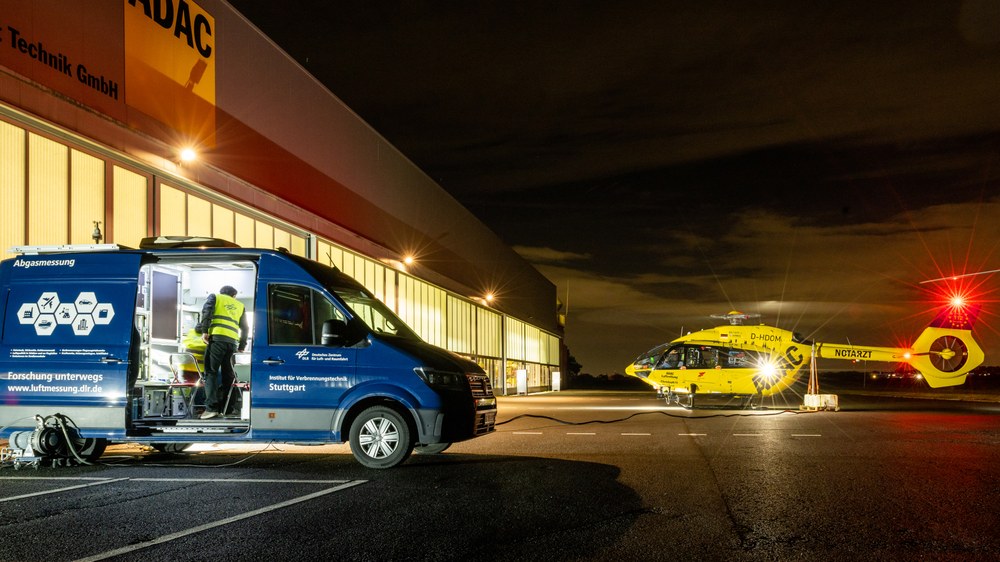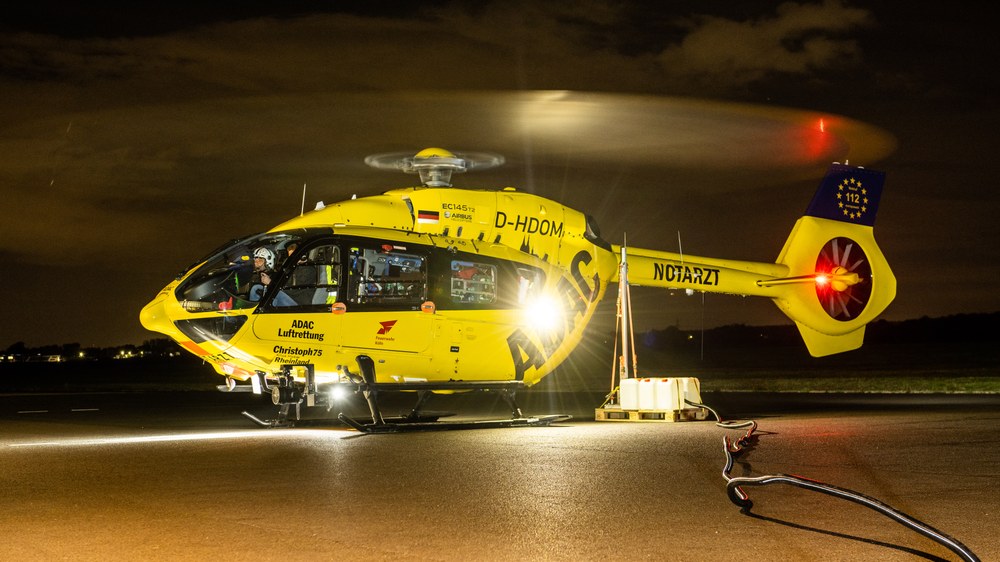DLR and ADAC Luftrettung test bio-kerosene in rescue helicopters


- DLR and ADAC Luftrettung have carried out their first study on the use of bio-kerosene for emergency medical flights.
- Two ADAC Luftrettung helicopters flew a sustainable aviation fuel blend combining bio-kerosene and conventional kerosene.
- A DLR team conducted a measurement campaign to analyse the emitted ultrafine particles and combustion gases.
- The findings revealed a significant reduction in ultrafine particles in the exhaust gases.
- Focus: Aviation, energy, climate-compatible flying, sustainable aviation fuels (SAF), bio-kerosene, measurement technology
The German Aerospace Center (Deutsches Zentrum für Luft- und Raumfahrt; DLR) has partnered with the non-profit organisation ADAC Luftrettung – the German air rescue service – to conduct a pioneering research campaign examining the use of sustainable aviation fuels (SAF) in rescue helicopters. For the trial, two ADAC Luftrettung helicopters completed over 1800 flight hours using a blend of conventional kerosene and SAF. The blend contained up to 38 percent SAF produced from recycled vegetable or animal fats, such as used cooking oil. Researchers from the DLR Institute of Combustion Technology supported the long-term trial with a total of six ground-based measurement campaigns. They examined the combustion behaviour and performance of the SAF blend, with a particular focus on analysing the emissions of ultrafine particles and gases such as carbon dioxide (CO₂), carbon monoxide (CO) and nitrogen oxides (NOₓ).
Significantly fewer soot particles with reliably high performance
DLR measurements showed that engines running on the SAF blend emitted significantly fewer ultrafine particles (UFPs) – commonly known as soot – compared to pure kerosene. During idle operation shortly before take-off, when rotor speeds are already high, researchers recorded a 44 percent reduction in UFPs. At engine power levels typical for cruising flight, particle emissions were 33 percent lower. The DLR team also found no notable changes in exhaust gases, demonstrating that the engines run smoothly and reliably with the SAF blend.
SAFs are an important step towards more climate-compatible aviation. These innovative fuels can be engineered to produce significantly fewer soot particles when burned, benefiting both the environment and the climate. In addition, the carbon dioxide released during combustion originates from renewable sources, such as plants and animals, which took in carbon dioxide during their lifetimes. This means net carbon dioxide emissions over the fuel's entire lifecycle are also substantially reduced.
Using DLR expertise to track even the tiniest particles
"For this first-of-its-kind measurement campaign, we deployed our mobile DLR measurement lab, which contains highly specialised measurement and analysis instruments capable of detecting ultrafine particles as small as seven nanometres," explains DLR researcher Tobias Grein, who oversaw the project. "Before each measurement campaign we develop a tailored approach, carefully determining the setup, the position of the measuring probe and the duration of each measurement. This meticulous preparation ensures reliable and comparable data". Tobias concludes: "These measurements were particularly exciting, and it was a unique experience for our team to conduct them 'live' on a helicopter just prior to takeoff."
"Following these promising first results, we aim to expand our research and development activities in this field and increase the SAF content," explains Frédéric Bruder, Managing Director of ADAC Luftrettung. "Our long-term goal is to significantly advance the decarbonisation of aviation, including in the emergency services sector. Scientific partners like DLR, with their extensive expertise and many years of experience, play a vital role in ensuring the success of such projects."
Advancing science and aviation
DLR's measurements provide detailed emission analysis categorised by particle size. Until now, helicopter emissions were largely estimated using approximation methods. "Thanks to these measurement campaigns with ADAC Luftrettung, we now have new, significantly more accurate data collected under real-world operational conditions," explains Tobias Grein, highlighting the importance of this work for research and the aviation sector. "This data can be used for extrapolations, simulations and modelling, allowing us to assess aviation's environmental and climatic impacts with much greater precision."
The DLR Institute of Combustion Technology, based in Stuttgart, specialises in optimising combustion processes to reduce emissions. Through close collaboration with industry and other research institutions, it plays a key role in the development and testing of sustainable fuel alternatives. To this end, it offers unique expertise, particularly in measurement technologies and their practical applications.
Related links
About ADAC Luftrettung
With 60 rescue helicopters operating from 38 stations, the non-profit ADAC Luftrettung is one of Europe's largest air rescue organisations and has carried out more than 1.3 million missions to date. ADAC rescue helicopters form an integral part of Germany's emergency medical services, are dispatched via the 112 emergency number and provide assistance to anyone who has suffered an accident or sudden illness. ADAC Luftrettung is a subsidiary of the non-profit ADAC Foundation.
